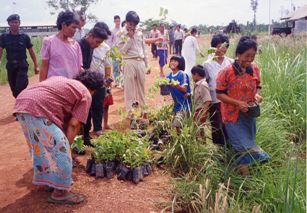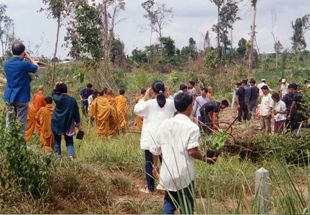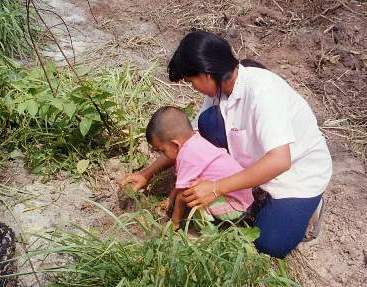


Selecting multipurpose trees
This module provides basic guidelines on how to select species of multipurpose trees that will meet farmers' particular needs. The importance of matching tree species with the characteristics of the site where they will be grown is stressed. The module also outlines the possible advantages of growing trees, whether it be for domestic purposes or for generating income.
What is a multipurpose tree?
Farmers have been growing trees for different purposes for thousands of years. Certainly, all trees provide shade and protection from soil erosion. In this sense, all trees can be said to have at least two purposes. More precisely, though, this manual uses the term multipurpose tree species to mean:
tree species that are grown to provide more than one significant crop of function or form. These may include soil conservation, shade, fuelwood, timber, fibre, fodder, food or medicine.
Tree species can be multipurpose in two ways:
- A single tree can yield more than one crop. For example, farmers in Central America and the Philippines grow Gliricidia sepium as living fences that provide fuel, fodder, and green manure for agricultural crops — all at the same time.
- Trees of the same species, when managed differently, can yield different crops. In the Philippines, for example, Leucaena leucocephala is managed so that some trees will principally yield wood while others principally produce leaf meal.
Farmers can grow multipurpose trees in various combinations with other crops, as in agroforestry, in block plantations of trees or in naturally regenerating tree farms.
In certain settings, multipurpose trees are grown and managed for only one purpose. In the Solomon Islands, Gliricida sepium is grown only to provide shade in coffee plantations. The same species is planted in Central America and the Philippines, yet the way it is managed results in a very different shape and use.
Farmers facing changing conditions in their environment or market can also change the way they manage a tree. For example, market changes may persuade farmers, who previously grew trees for fodder and fuel, to cut their trees for sale as roundwood for construction material.
Why grow multipurpose trees?
Reducing risk of total crop failure
Growing multurpose trees can reduce the risk of total crop failure. For example, if farmers usually grow Leucaena leucocephala for animal fodder and the tree's leaves are destroyed by pests, they will still have wood that can be used for fuel, pulp, or light-weight construction material.
Having a variety of plants on a farm, as in agroforestry systems, can also reduce the risk of total crop failure. Evidence shows that combining several types of plants provides a type of insurance. If the economic benefit of one crop is reduced by pest damage or market failure, the farmer can make up for it by harvesting another crop. Also, growing a variety of species makes the farm less vulnerable to any one pest.
Income generation and distribution
Agroforestry practices can increase farmers' annual income. Some increases in revenue come from harvesting different tree crops in different seasons. For example, in many Asian countries farmers use the leaves off Artocarpus heterophyllus (jackfruit) as fodder during the driest season. The same trees produce fruits providing income and food to the owner at other times. The result is that income and employment are distributed more evenly throughout the year.
Of course there are many other reasons for growing trees on farms. Trees provide shade for a cooler soil temperature, reduce loss of soil moisture and also protect the soil from wind and water erosion.
Selecting appropriate species
Successfully growing multipurpose trees depends, to a great extent, on selecting the most appropriate species. To do this, farmers must first have a clear idea of why they wish to grow multipurpose trees and which tree crops match the needs of their particular farming system and local agroecological conditions.
People grow trees for different purposes: to obtain timber, fuelwood, fodder, or food; to conserve the soil; or a combination of these. Trees can also be grown in different land use systems, such as alley cropping, home gardens, farm woodlots, or industrial plantations. These different purposes and growing systems determine the criteria that farmers must consider when selecting which species to grow.
Fuelwood
Species grown for this purpose should:
- adapt quickly and yield a maximum volume of wood in a short time;
- stabilise the soil and maintain its fertility;
- require minimum time and effort for management;
- tolerate diseases and pests;
- tolerate drought and other climatic stresses;
- coppice well, that is readily sprout shoots from stumps;
- have other uses that contribute to the farm enterprose;
- produce trees without thorns and whose stems and branches have a diameter small enough to be cut with hand tools and be easily transported;
- produce wood that splits easily;
- have a low moisture content or dry relatively quickly;
- produce minimal and nontoxic smoke (low ash and sulphur content) when burned;
- not spit or spark while burning, for safety reasons;
- produce dense wood, to burn longer.
Some species often used for fuelwood are: Acacia auriculiformis, Casuarina equisetifolia, Gliricidia sepium, Calliandra calothyrsus, and Leucaena leucocephala.
Roundwood (poles and posts)
Species grown for this purpose should:
- Have a straight stem;
- have a single main stem rather than multiple stems;
- produce few or thin branches;
- be self pruning and without knots, for strength;
- have little taper from bottom to top;
- have bark that strips easily;
- produce wood that is durable, light, and capable of supporting heavy cross loads;
- resist termites and other wood borers;
- be able to absorb chemical preservatives easily.
Some species often used for roundwood are: Acacia auriculiformis, Acacia mangium, Albizia lebbek, and Casuarina equisetifolia.
Fodder
Species grown for this purpose should:
- produce leaves or pods that animals like to eat;
- withstand lopping, pruning, pollarding, and coppicing;
- grow quickly, especially in early stages;
- adapt easily to different sites and environments;
- withstand intense shade if planted with other species;
- fix nitrogen to enhance soil fertility;
- withstand damage by pests, diseases, and browsing animals;
- have other uses.
Some species often used for fodder are: Faidherbia albida, Albizia lebbek, Leucaena leucocephala, Azadirachta indica, Artocarpus heterophyllus, Gliridia sepium, Prosopis cineraria and Sesbania grandiflora.
Live fences
Species planted for this purpose should:
- grow well under adverse conditions;
- grow well in close spacing;
- require minimal maintenance;
- withstand lopping and trimming;
- propagate easily from cuttings;
- grow fast to a medium height, and be long-lived;
- have prickles or stiff branches and leaves that animals don't like to eat; and
- produce suckers.
Some species often used for live fences are: Cajanus cajan, Erythrina poeppigiana, Calliandra calothyrthus, Gliricidia sepium, Casuarina equisetifolia and Pithecellobium dulce.
(To be added)
Windbreaks and shelterbelts
Species grown for this purpose should:
- tolerate harsh environments;
- have a bushy, deep crown that still allows some wind penetration;
- keep lower limbs for a long time;
- have strong roots;
- grow quickly;
- live long
- tolerate pests and diseases; and
- not have roots that compete excessively with nearby crops for water and nutrients.
Some species often used for windbreaks and shelterbelts are: Casuarina equisetifolia and Erythrina peoppigiana.
Soil protection and rehabilitation
Species grown for this purpose should:
- grow fast;
- grow well under adverse conditions;
- have a spreading crown;
- have a vigorous root system to bind the soil and a strong taproot especially in the areas prone to landslides;
- associate well with nitrogen-fixing organisms and mycorrhizal fungi in the soil;
- reproduce vigorously, for example, from root suckers, or through abundant natural seed fall and seedling development; and
- tolerate fire.
Some species often used for soil protection and rehabilitation are: Acacia auriculiformis, Casuarina equisetifolia and Prosopis juliflora.
Shade and nurse trees
Species grown for this purpose should:
- have fast early growth;
- establish easily, preferably by cuttings;
- be evergreen;
- live long;
- tolerat soil compaction by animals walking and sitting beneath them, as happens on pasture land;
- coppice well and withstand some lopping;
- fix nitrogen in the soil to enhance soil fertility;
- have a dense, spresing crown, if used to shade grazing animals;
- have a light crown, if used as nurse trees for other crops; and
- not compete with crops for soil nutrients if used as nurse trees.
Some species often used as shade or nurse trees are: Erythrina poeppigiana, Gliricidia sepium, Leucaena leucocephala, and Sesbania grandiflora.
Decoration and enjoyment
Species grow for this should:
- grow fast;
- perhaps be evergreen;
- have attractive flowers and possibly fruits that can be eaten by birds and small animals;
- have a heavy and spreading crown, if shade is desired;
- establish easily;
- tolerate adverse site conditions;
- tolerate some pruning;
- require little maintenance;
- protect the soil; and
- not have a large bilateral root system, where planting is near buildings or paved roads.
Some species often used for decoration and enjoyment are: Acacia auriculiformis, Casuarina equisetifolia, Pterocarpus indicus, Albizia saman and Tamarindus indica.
Industrial uses
Species grown for sawn timber, plywood, veneer, pulpwood, or other industrial uses should:
- grow fast;
- have a maximum rate of growth in early stages of development;
- have a straight stem, uniform size, and small branches;
- show good natural pruning with rapid healing of wounds if used for producing sawn timber and plywood.
- have a good physical, mechanical seasoning, preserving and processing properties if used for producing sawn timber;
- have wood that is easy to peel, slice, and free of knots if used for producing plywood and veneer;
- have wood with a high density and, preferably, long fibres if used for producing pulp.
Some species often grown for industrial uses are: Pinus spp, Tectona grandis, Populus spp and Terminalia spp. (for sawn timber); Dipterocarpus spp and Tectona grandis (for pywood and veneer); Acacia spp, Leucaena spp, Pinus spp, and Eucalyptus spp (for pulpwood).
Trees can also be planted to produce other commodities: Eucalyptus spp (essential oils and honey), Acacia spp (tannin for making dyes), Azadirachta indica (pesticides), Morus alba (silk), and Hevea brasiliensis (latex).
Matching species to requirements
Site characteristics
Multipurpose trees offer many opportunities but do not guarantee benefits. When selecting a species, it is important to consider soil conditions, climate and topography. After deciding on the planting objective and learning about the soil, rainfall and other conditions of the planting site, the farmer can decide whether to grow indigenous or exotic species.
Indigenous versus exotic species
Species found growing in nearby natural stands, or trees growing well in neighbouring plantations are good choices. Some of these species may be indigenous, which grow and reproduce naturally in the region. Others may be exotics, that is, have been introduced from another region or even another country. For example, Eucalyptus spp were introduced throughout Asia from Australia.
When introducing an exotic species it is important to determine whether the soil, rainfall, and other requirements of the species match the conditions of the planting site. If the most suitable species are not known and there are only a few sources of tree seed in the area, indigenous species as well as local exotic species should be considered first. Local exotic species are those found in botanic gardens, on farms, in parks or along roadsides and that have survived under local agroecological conditions.
Environmental matching
The most frequently used technique for selecting an exotic species is called environmental matching. The technique calls for examining the species in its home environment or testing its growth in other countries with environmental conditions similar to those found in the home environment. Some species grow well in areas far from their original home if the new place has the same type of environment. When ordering seeds from outside the area to be planted, obtain supplies from more than one source. If one source performs poorly, there is still a chance that seed from another source will succeed.
Preferences of end users
Species should match the preferences and needs of end users. When farmers grow trees for their own use, they know the types of tree crops that they wish to obtain. When farmers grow trees for sale, it is important that they know the preferences of buyers.
Technical requirements
Some species require intensive management techniques beyond the means of small-scale farmers. Such species should be avoided, regardless of potentials they may appear to have.
Potential competition with other crops
Introducing an exotic species can result in undesirable side effects. One possible problem is that the species will adapt so well to its new environment that it will become a weed and take over crops that are important to farmers' livelihood. For example, Prosopis juliflora, native to Central America and the West Indies, was introduced to India as a fodder and fuelwood tree.
Some scientists say that it grows so well in its new environment that it inhibits the germination and growth of other plants that are more valuable to the farmer.
Availability of Planting Material
Seeds or seedlings of the selected species should be readily available. Availability of planting material can be limited because:
- It is difficult to grow seedlings in local nurseries.
- It is difficult to establish the seedlings in local plantations.
- There are quarantine restrictions on seed coming into the country.
- Seeds and seedlings of the species are susceptible to local diseases and pests.
Suggested Readings
Boland, D.J. 1986. Selection of Species and Provenances for Tree Introduction. In: J.W.Turnbull, ed. Multipurpose Australian Trees and Shrubs: Lesser-known Species for Fuelwood and Agroforestry. Canberra, Australia: ACIAR.
Brewbaker, J.L. 1987. Significant Nitrogen-Fixing Trees in Agroforestry Systems. In: H.L. Gholz, ed. Agroforestry: Realities, Possibilities and Potentials. Dordrecht, Netherlands: Martinus Nijhoff.
MacDicken, K. 1988. Nitrogen-Fixing Trees for Wastelands. Bangkok, Thailand: FAO-RAPA. Selecting Multipurpose TreesMacDicken, K. and J.B. Raintree. 1991. An Overview of Multipurpose Tree Species. In: Research on Multipurpose Tree Species in Asia. Proceedings of an international workshop, November 19-23,1990, Los Banos, Philippines. Bangkok: Winrock International.
Verheij, E.W.M. and R.E. Coronet, eds. 1991. Plant Resources of South East Asia, No. 2: Edible Fruits and Nuts. Bogor, Indonesia: Prosea Foundation.